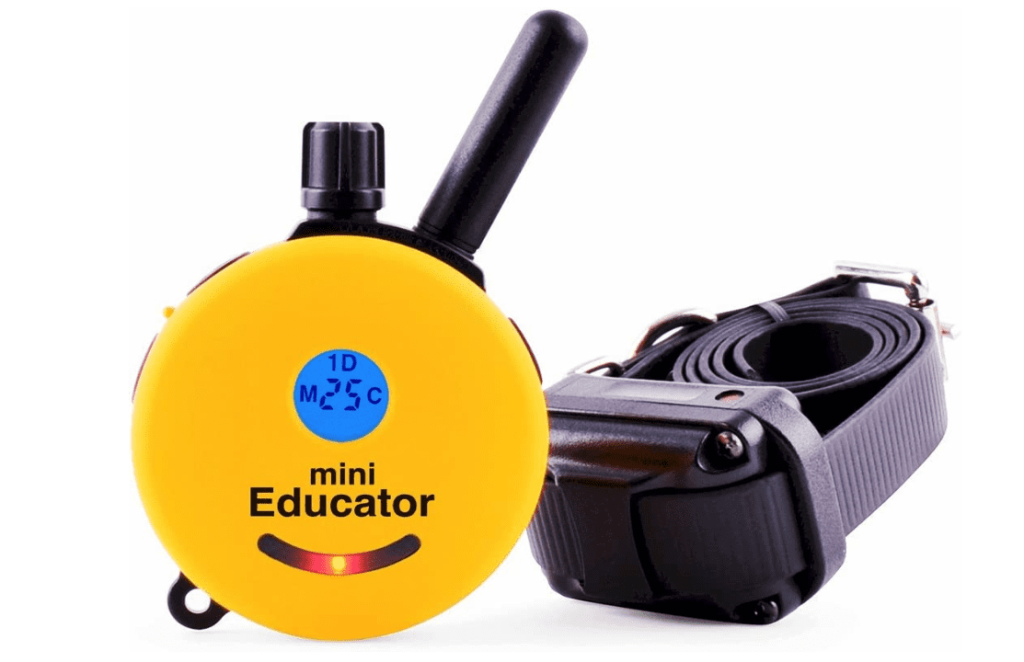The hottest topic in the dog community is Shock Vs E-collar to determine if they are humane enough for dog training or not. Plus, these collars have evoked fear of harming their dogs.
It is because of the lack of knowledge between these two collars functioning and designing logic. Additionally, there has a slight difference even though they are used for the same objective.
Based on it, e-collars are a great help in training your dog as they allow you to adjust the stimulation and don’t produce shock. In contrast, shock collars are outdated and slightly controversial versions of an e-collar.
But don’t jump to a conclusion based on one fact just yet. In the article, you will discover more aspects of the debate over Shock Collar Vs. E-Collar.
Let’s dive into the details to get a clear view of our take on the matter.
Overview: Shock Collar Vs. E- Collar
There are many common myths and misunderstandings surrounding shock collars and E-Collars. Hence, here is an overview of both devices for a better and more precise understanding.
Shock Collars

Shock Collars and E-Collars are both generally considered the same thing and are named interchangeably for one another. However, both devices have tiny differences as the technology differs slightly.
Additionally, they were made very basic, and some of them were made to release a current to prevent a dog from doing a certain thing. However, it was not made to cause harm to your dog.
E-Collars

Electric collars are the ones used in the era of 1970s to restrain your dog’s actions. However, the modern e-collars we use today aren’t made to release current. It simply stimulates different types of corrections.
An essential factor about E-Collars is that they don’t release shock. Instead, they use electronic stimulation, which you can control with a remote. Hence, this process does not involve any negative reinforcement.
Plus, it helps you stop your dog’s wrong behaviors by giving them a tiny feeling of discomfort.
Moreover, you should not be concerned with the stimulation intensity as the modern-day e-collars allow you to adjust the different correction levels. These levels can be changed according to your dog’s size and behavior.
Ultimately, you should use this type of collar only while training your dog and not always.
Differences: Shock Collar Vs. E- Collar
As mentioned before, there is a slight difference between the two collar types, shock collar, and e-collar. Also, both collars try to accomplish the same motive but via different means of stimulation.

As many people and dog trainers mentioned multiple times, e-collars were introduced in the 1970s to punish dogs by releasing shocks via e-collar with remote control. Hence, people started calling e- collars shock collars.
Nonetheless, this interchange of both terms cannot apply to today’s modern-day e-collars.
Modern-day collars use different types of electronic stimulations instead of electronic shocks. In this method, the e-collars usually release mild vibrations just to make the dog stop their wrong actions. Hence, it doesn’t cause any pain to the dog.
The logic of re-designing the collar was to make it a positive experience for the dog to be trained with an e-collar.
Ultimately, you can say that a shock collar is an outdated version of an E-Collar.
Shock Collar Vs. E- Collar: How do they work?
E-collars are controlled with the help of a remote by the remote holder and a receiver attached to a collar that your dog should wear.
E- collars use electronic stimulation on a mild level, which is different from releasing shocks. It’s not triggering for a dog as it only gives a tingling sensation to your dog’s neck skin.
In short, your dog’s wrong behavior can be stopped with little sense of discomfort. Moreover, this stimulation can be adjusted as per your desired intensity levels.
Some e-collars have multiple stimulation modes such as Beep, Vibration, and Ultrasonic sound (which dogs can only hear).
Additionally, some e-collars have GPS Trackers to help you track your dog’s whereabouts and follow his trails.
Now that you know how an e-collar works, you should know shock collars are not that different.
To be precise, shock collars work like electronic collars but release actual shock instead of electronic stimulation such as vibrations. Also, they usually don’t have any additional features like an e-collar (In most cases).
Shock Collar Vs. E- Collar: What is Safer?
While talking about safety, I can guarantee that it is a safer option for your dog to correct its action. The correction intensity that an e-collar produces can be similar to a mosquito bite at a mild level.
Moreover, even if you increase the levels of intensity, it won’t harm your dog, but it might trigger anxiety in your dog if he is fragile.
Hence, it is recommended to start training your dog with lower-intensity settings to notice how your dog reacts to the stimulations.
Ultimately, it turns out safe for your dog.
On the other hand, shock collars are considered quite inhumane as the discomfort they cause is questionable, and they don’t work well with correcting a dog’s behavior. Instead, it just gives a boost to your dog’s aggression.
Small mistakes while using a shock collar can cause trigger your dog’s fear, anxiety, and aggressive behavior.
Therefore, shock collars can sometimes be considered unsafe, and e-collars are considered safer in any scenario.
Pros And Cons: Shock Collar Vs. E- Collar
If you look at the general Shock Collar and E-Collar, both are initially the same devices, even though their technology differs slightly. However, using these collars for your dog has some advantages and disadvantages.
So to look at both sides of these collars, let’s check out the shock collar and e-collar’s pros and cons below.
Pros and Cons of Shock Collar
Here are the pros and cons of a shock collar:
Pros
- It is safer for dogs.
- It can be a useful tool for training if used properly.
- You can correct your dog’s stubborn behaviors if they are difficult to use.
- You adjust the correction levels as per your dog.
Cons
- It can be harmful to your dog if used recklessly.
- Inclines towards negative reinforcements.
Pros and Cons of E-Collar
Here are the pros and cons of an E-collar:
Pros
- Like shock collars, e-collars can also be useful for training your dog.
- It is safer for your dog.
- There are multiple other features to use while training your dog.
- E-collars also help in correcting your dog when he is running out of your sight.
Cons
- E-collars can also cause harm if it is used incorrectly.
- It may trigger anxiety in your dog.
Related Reads:
- Fi Smart Dog Collar Review
- Comparing Dog Harness and Collar for your dog
- Spot On Collar vs Halo Collar: Choosing the Right Option
Final Verdict: which one is better?
The terms shock collar and “E-Collar” are frequently used alternatively by individuals who support or oppose the use of these types of collars.
There is hardly a differentiation between them. Such collars can be very effective tools for training if utilized correctly, and they might even work as an extra measure for keeping a dog safe if all other approaches have failed.
The effectiveness and humaneness of employing these collars are hotly debated topics. What is best for your dog ultimately depends on you, the owner, and the trainer.
FAQs
Usually, both shock and e-collars are technically considered the same by many people, but they are used with different intentions.
Shock collars are widely rejected and opposed by vets worldwide.
Vibrating collars (basically an e-collar) are the best and ultimate alternative instead of a shock collar.
